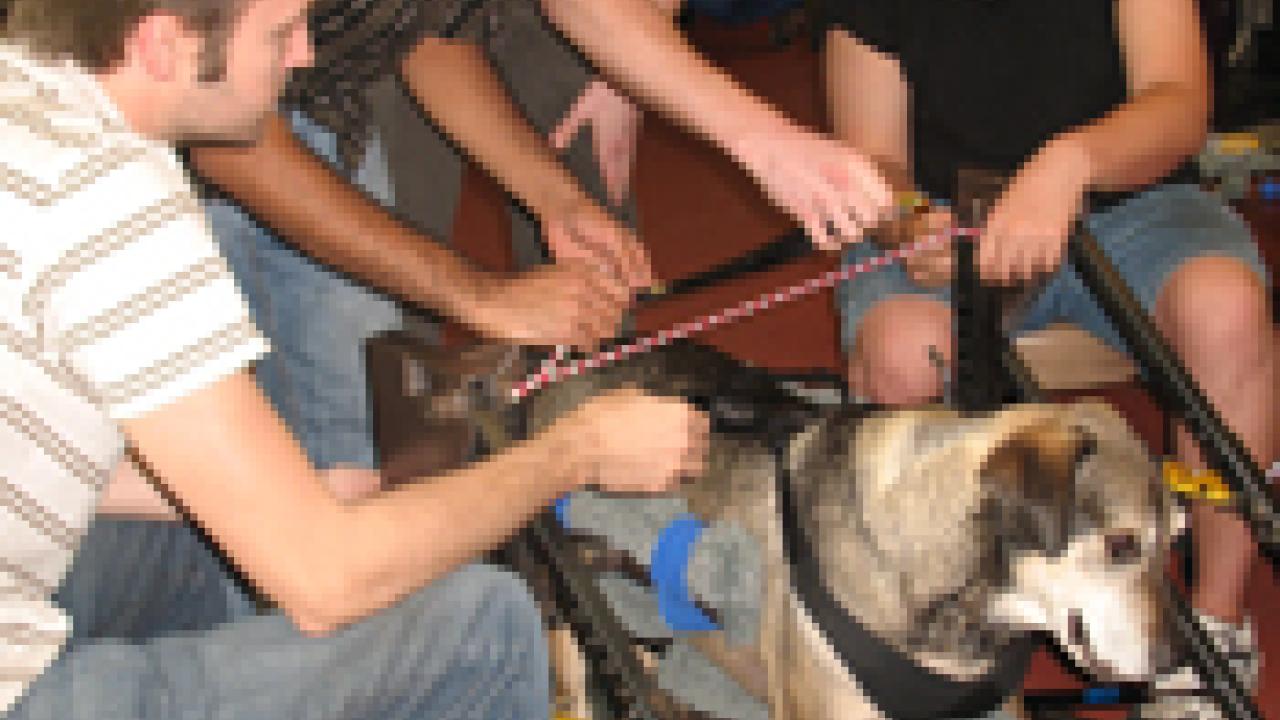At 12:30 p.m. on June 8 four nervous mechanical engineering students wheeled the culmination of six months of their design and fabrication work into the Physical Rehabilitation Center at the UC Davis Veterinary Medical Teaching Hospital.
The group was greeted by physical therapist Jackie Woelz and her 7-year-old patient, Chelsea, a sweet-tempered lab and shepherd mix whose surgery for a brain tumor last December had left her barely able to move her left legs.
For 45 minutes, Nelson Dichter, Jay Panchal, David Shira and Blake Summers fiddled with their four-wheeled, metal-frame structure until it was finally ready to help Chelsea learn to walk again.
Interdisciplinary problem-solving
Student engineering projects are nothing new. In fact, to be accredited, college engineering programs around the country must include “capstone” classes that meld four years of coursework with hands-on design and construction projects.
But at UC Davis, capstone classes provide mechanical and biomedical engineering students with a wealth of opportunities.
Bruce White, dean of the College of Engineering, said, “Not only do we have our veterinary and medical schools to draw on, but we’ve also engaged outside companies to work with our students. This ensures that our undergraduates are learning about real-world industrial problems, and experiencing first-hand how engineering interfaces with business processes.”
Medical, veterinary collaborations
Collaborations between engineering students and medical school faculty were boosted this year when the school’s Clinical and Translational Science Center threw its weight behind the capstone classes.
Forging ties between medical researchers and budding engineers seemed an ideal way for the center to help achieve its goal of moving research from the laboratory to patient care as quickly as possible, explained Nicholas Kenyon, director of one of the center’s training programs.
During fall quarter Kenyon and Cristina Davis, an assistant engineering professor who heads the mechanical engineering capstone course, sent e-mail messages to every faculty member at the School of Medicine. Did anyone need a device, the pair asked, that could improve patient care — a device that did not yet exist?
A similar note went to all veterinary school faculty from associate professor of biomedical engineering Angelique Louie, who has led the biomedical capstone class since its inception in 2006.
Together the e-mails yielded projects for 11 biomedical engineering and eight mechanical engineering teams, totaling about 80 students. (Another six mechanical engineering teams took on projects without a biological component.) Kenyon also arranged for the CTSC to provide $5,000 to three student teams for purchase of parts and materials for their devices.
Artificial muscle to close eyelids
It did not take Travis Tollefson more than a blink of an eye — literally — to come up with an answer to Kenyon’s query. A facial reconstruction surgeon at the medical school, Tollefson and colleague Craig Senders had spent several years developing an apparatus that would allow victims of facial paralysis to blink their eyes. At this point, an engineering team was just what they needed.
The basis of the duo’s work is a material developed by SRI International that functions much like muscle tissue. Using the faux tissue to tighten a sling of fabric sewn into the inner eyelids of cadavers, the two had already demonstrated that their device could fully close the lids.
Their problem, however, was space.
For the system to be fully implantable under the skin, it had to fit into a hollow in the skull just below the temple, which was simply too small.
What the doctors needed was a miniature mechanism to amplify the material’s force — a design project that fell to biomedical engineering students Roozbeh Ahmadi, Justin Chen and Abhiram Varadarajan.
Chen said, “The miniaturization process had its own big set of design challenges. We also had to make the device biocompatible.”
The students met with Tollefson and Senders about 10 times during winter and spring quarters.
Though they have completed their prototype, they plan to work on it through the summer, with the goal of testing it on cadavers.
Walking with Chelsea
While Tollefson’s biomedical engineering team struggled with miniaturization, the team of Dichter, Panchal, Shira and Summers went straight from the design room to the Bainer Hall engineering shop. Using welding torches, grinders, hacksaws and an assortment of other tools, the four labored over a device that was to double for Jackie Woelz’s hands.
“What I needed was a device that allows a dog who is only weakly ambulatory to have the same freedom of movement it would have if I was hand-holding it,” said Woelz (pronounced “Wells”). “Right now, there’s nothing on the market that can do this, so I have to use my hands. But I can’t hold up every dog that needs help.”
Chelsea did not pay much attention to the adjustable, padded supports and side rails that were being fitted under and around her. The affable pooch seemed much more interested in the attention she was receiving as the first animal to test the new device.
When the supports were in place, the dog stood motionless for a moment, then pushed forward with her two good legs. The team stopped her to do more adjusting before letting her take another step.
“It’s working,” Woelz said. “This is great. It’s going to help a lot of our patients.”
At the end of the session, the four students told Woelz that they planned to spend several more days fine-tuning the rolling canine support. After that, they would do what every other team did, turn the device over to their faculty collaborator.
Woelz was clearly pleased. “These students have been fantastic to work with,” she said. “So professional and so ingenious. It’s been a wonderful collaboration.”
Media Resources
Clifton B. Parker, Dateline, (530) 752-1932, cparker@ucdavis.edu
